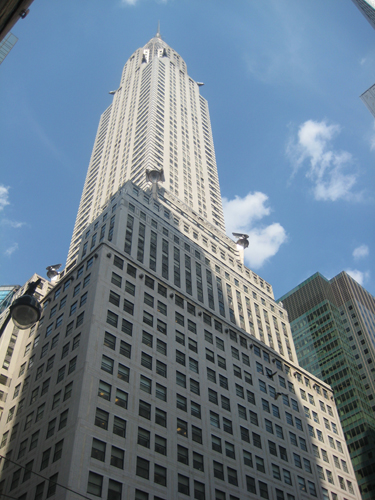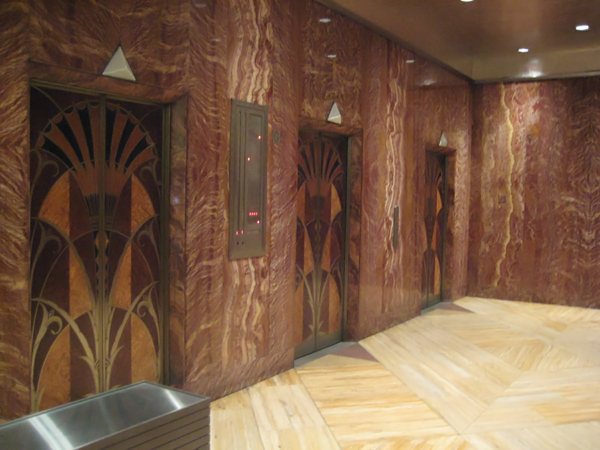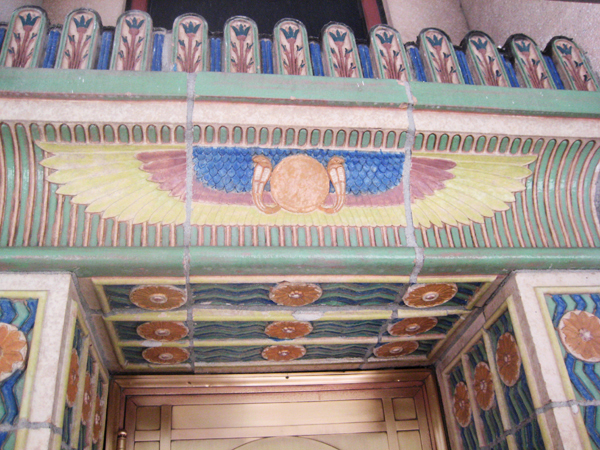
In the 1920s and 30s, Art Deco was the rage in visual arts, interior design, and architecture. Adopted from the French, Art Deco was a design movement of natural geometric simplicity, a modernization and mix of classical styles with appeals to other movements such as Cubism, Futurism, Art Noveau, and Bauhaus. Egyptian Revivalism was one of the many classical and exotic styles used in Art Deco. Howard Carter's discovery of the tomb of Tutankamun (1343-1333 B.C.) in 1922 created a new wave of Egyptomania (Egyptomania!) and popularized Egyptian motifs in architecture and design. There are many great examples of Art Deco architecture in New York City, and several find inspiration from Egypt.
Fred F. French Building
551 Fifth Ave. and 45th St.
Subway: 7 to Fifth Ave. and 42nd St.; B,D,F,V to 47-50th Sts. Rockefeller-Center



Fred F. French Building
Fred Fillmore French (1883-1936) was a New York real-estate developer who worked on development projects such as Knickerbocker Village (low-income housing on the Lower East Side), Tudor City (a middle-class development on the East side), and the Fifth Avenue skyscraper named after himself. Designed by H. Douglas Ives with the Sloan & Robinson Firm in 1927, the French Building is a blend of ancient Near East, Egyptian, Greek, and Art Deco motifs. The facade is more like an Assyrian ziggurat than an Egyptian temple, but the floral motif on the metalwork is in an Egyptian style.
The Chrysler Building
405 Lexington Ave., Turtle Bay, Midtown East
Subway: 4,5,6,7,S to Grand Central


Chrysler Building
Designed by Will van Alen between 1928 and 1930, the Chrysler Building combines a range Art Deco motifs. The lotuses decorating the interior elevator doors are certainly Egyptian in style.
The Pythian Temple
135 W 70th St., Upper West Side
Subway: 1 to 66th St. Lincoln Center; B,C to 72nd St.


The Pythian
NYC's best example of Egyptian Revival architecture, the Pythian Temple was designed by architect Thomas Lamb and completed in 1927. The "temple" was built for Masonic "Knights of Pythias" (founded during Civil War in Washington, D.C.) and became a branch for Manhattan Community College in the 1950s. Since 1982, many windows have been added and the Pythian now serves as luxury condominiums. Its street facade features Egyptian designs from columns, painted motifs with winged sun disks, and Egyptian pharonic statues. It is similar to the Edfu Temple, a well-preserved Ptolemaic temple (332-30 B.C.) between modern Aswan and Luxor. The Pythian's four seated Egyptian statues located toward the top on the front of the building, echo those statues of pharaoh Ramesses II (1279-1212 B.C.) at his Abu Simbel temple in Nubia; Abu Simbel includes four colossal statues of the king. Above the door of NYC's temple is a Pythian inscription in gold letters that reads, "If fraternal love held all men bound how beautiful this world would be."
Museum of Jewish Heritage: a Living Memorial to the Holocaust
Edmond J. Safra Plaza
36 Battery Pl., Battery Park
Subway: 4,5 to Bowling Green
www.mjhnyc.org
![[image]](images/24. JewishHitPyramid.jpg)
Museum of Jewish Heritage: A Living Memorial to the Holocaust, Battery Park
Designed by Kevin Roche and opened in 1997, this museum dedicated to the memory of the Holocaust is obviously not Art Deco. But it seems to follow Art Deco's adapting of Egyptian forms, in this case a pyramid topping off the 85-foot-tall building. It is reminiscent of the first Egyptian pyramid ever constructed, the Step Pyramid at Saqqara built by King Djoser of the 3rd Dynasty (2584-2565 B.C.).
Advertisement

Advertisement







